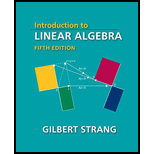
Concept explainers
(a)
The
The column space of A is spanned by vectors u and w.
Given:
Sum of two matrices of rank one is A:
Calculation:
Consider the equation
We can clearly see that the vectors u and w span the column space of A.
Thus, the column space of A is spanned by vectors u and w.
(b)
To Calculate:
The vectors that span the row space of A when A is the sum of two matrices of rank one:
The row space of A is spanned by vectors v and z.
Given:
Sum of two matrices of rank one is A:
Calculation:
Consider the equation
We can clearly see that the vectors v and z span the row space of A.
Thus, the row space of A is spanned by vectors v and z.
(c) To Fill:
The blank space.
The rank is less than 2 if vectors u and w are collinear/dependent or if vectors v and z are collinear/dependent.
Given:
The rank is less than 2 if ____ or if _____.
Sum of two matrices of rank one is A:
Calculation:
Collinear means that one vector is multiple of another and it is noted that two collinear vectors are always meant to be linearly dependent.
It is observed that u and w are multiples of each other and also v and z are collinear because they are also multiple of each other.
Therefore, the rank of matrix A is less than 2 only when the vectors u and w are dependent or when the vectors v and z are dependent.
(d)
A and its rank if
The rank of
Given:
Sum of two matrices of rank one is A:
Calculation:
Substitute the values of
Therefore, the rank of matrix A is
(b)
To Calculate:
The vectors that span the row space of A when A is the sum of two matrices of rank one:
The row space of A is spanned by vectors v and z.
Given:
Sum of two matrices of rank one is A:
Calculation:
Consider the equation
We can clearly see that the vectors v and z span the row space of A.
Thus, the row space of A is spanned by vectors v and z.
(c) To Fill:
The blank space.
The rank is less than 2 if vectors u and w are collinear/dependent or if vectors v and z are collinear/dependent.
Given:
The rank is less than 2 if ____ or if _____.
Sum of two matrices of rank one is A:
Calculation:
Collinear means that one vector is multiple of another and it is noted that two collinear vectors are always meant to be linearly dependent.
It is observed that u and w are multiples of each other and also v and z are collinear because they are also multiple of each other.
Therefore, the rank of matrix A is less than 2 only when the vectors u and w are dependent or when the vectors v and z are dependent.
(d)
A and its rank if
The rank of
Given:
Sum of two matrices of rank one is A:
Calculation:
Substitute the values of
Therefore, the rank of matrix A is
(c) To Fill:
The blank space.
The rank is less than 2 if vectors u and w are collinear/dependent or if vectors v and z are collinear/dependent.
Given:
The rank is less than 2 if ____ or if _____.
Sum of two matrices of rank one is A:
Calculation:
Collinear means that one vector is multiple of another and it is noted that two collinear vectors are always meant to be linearly dependent.
It is observed that u and w are multiples of each other and also v and z are collinear because they are also multiple of each other.
Therefore, the rank of matrix A is less than 2 only when the vectors u and w are dependent or when the vectors v and z are dependent.
(d)
A and its rank if
The rank of
Given:
Sum of two matrices of rank one is A:
Calculation:
Substitute the values of
Therefore, the rank of matrix A is
(d)
A and its rank if
The rank of
Given:
Sum of two matrices of rank one is A:
Calculation:
Substitute the values of
Therefore, the rank of matrix A is
Want to see the full answer?
Check out a sample textbook solution
Chapter 3 Solutions
Introduction to Linear Algebra, Fifth Edition
 Algebra and Trigonometry (6th Edition)AlgebraISBN:9780134463216Author:Robert F. BlitzerPublisher:PEARSON
Algebra and Trigonometry (6th Edition)AlgebraISBN:9780134463216Author:Robert F. BlitzerPublisher:PEARSON Contemporary Abstract AlgebraAlgebraISBN:9781305657960Author:Joseph GallianPublisher:Cengage Learning
Contemporary Abstract AlgebraAlgebraISBN:9781305657960Author:Joseph GallianPublisher:Cengage Learning Linear Algebra: A Modern IntroductionAlgebraISBN:9781285463247Author:David PoolePublisher:Cengage Learning
Linear Algebra: A Modern IntroductionAlgebraISBN:9781285463247Author:David PoolePublisher:Cengage Learning Algebra And Trigonometry (11th Edition)AlgebraISBN:9780135163078Author:Michael SullivanPublisher:PEARSON
Algebra And Trigonometry (11th Edition)AlgebraISBN:9780135163078Author:Michael SullivanPublisher:PEARSON Introduction to Linear Algebra, Fifth EditionAlgebraISBN:9780980232776Author:Gilbert StrangPublisher:Wellesley-Cambridge Press
Introduction to Linear Algebra, Fifth EditionAlgebraISBN:9780980232776Author:Gilbert StrangPublisher:Wellesley-Cambridge Press College Algebra (Collegiate Math)AlgebraISBN:9780077836344Author:Julie Miller, Donna GerkenPublisher:McGraw-Hill Education
College Algebra (Collegiate Math)AlgebraISBN:9780077836344Author:Julie Miller, Donna GerkenPublisher:McGraw-Hill Education





